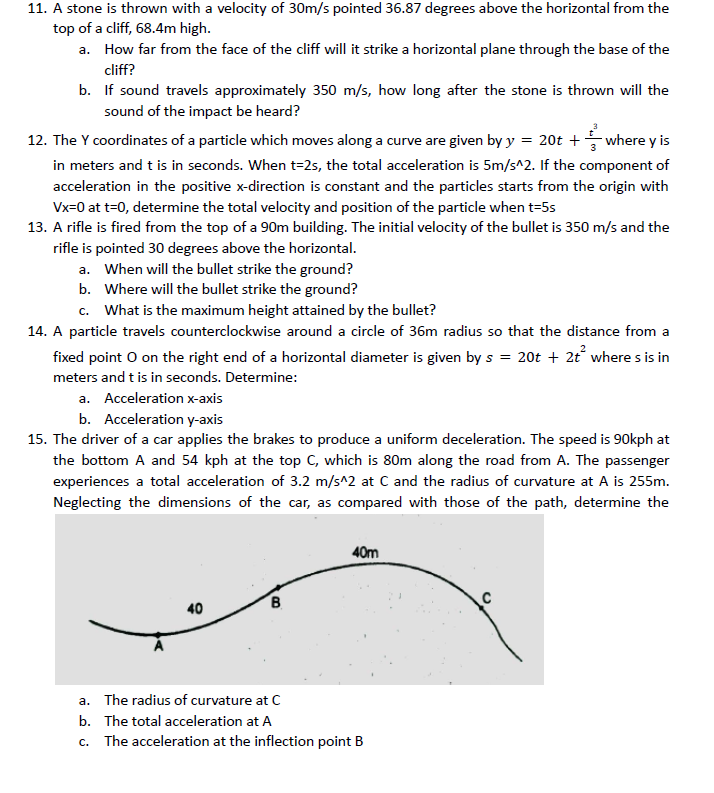A rifle is fired from the top of a 90m building. The initial velocity of the bullet is 350 m/s and the rifle is pointed 30 degrees above the horizontal. a. When will the bullet strike the ground? b. Where will the bullet strike the ground? c. What is the maximum height attained by the bullet?
A rifle is fired from the top of a 90m building. The initial velocity of the bullet is 350 m/s and the rifle is pointed 30 degrees above the horizontal. a. When will the bullet strike the ground? b. Where will the bullet strike the ground? c. What is the maximum height attained by the bullet?
Physics for Scientists and Engineers: Foundations and Connections
1st Edition
ISBN:9781133939146
Author:Katz, Debora M.
Publisher:Katz, Debora M.
Chapter2: One Dimensional Motion
Section: Chapter Questions
Problem 38PQ: During a bungee jump, a student (i) initially moves downward with increasing speed and then (ii)...
Related questions
Question
! COMPLETE SOLUTION !
pls answer NO. 13
*draw FBD
*use data given below properly

Transcribed Image Text:11. A stone is thrown with a velocity of 30m/s pointed 36.87 degrees above the horizontal from the
top of a cliff, 68.4m high.
a. How far from the face of the cliff will it strike a horizontal plane through the base of the
cliff?
b. If sound travels approximately 350 m/s, how long after the stone is thrown will the
sound of the impact be heard?
12. The Y coordinates of a particle which moves along a curve are given by y = 20t + where y is
in meters and t is in seconds. When t=2s, the total acceleration is 5m/s^2. If the component of
acceleration in the positive x-direction is constant and the particles starts from the origin with
Vx=0 at t=0, determine the total velocity and position of the particle when t=5s
13. A rifle is fired from the top of a 90m building. The initial velocity of the bullet is 350 m/s and the
rifle is pointed 30 degrees above the horizontal.
a. When will the bullet strike the ground?
b. Where will the bullet strike the ground?
c. What is the maximum height attained by the bullet?
14. A particle travels counterclockwise around a circle of 36m radius so that the distance from a
fixed point O on the right end of a horizontal diameter is given by s = 20t + 2t where s is in
meters and t is in seconds. Determine:
a. Acceleration x-axis
b. Acceleration y-axis
15. The driver of a car applies the brakes to produce a uniform deceleration. The speed is 90kph at
the bottom A and 54 kph at the top C, which is 80m along the road from A. The passenger
experiences a total acceleration of 3.2 m/s^2 at C and the radius of curvature at A is 255m.
Neglecting the dimensions of the car, as compared with those of the path, determine the
40m
40
B.
a. The radius of curvature at C
b. The total acceleration at A
c. The acceleration at the inflection point B
Expert Solution
This question has been solved!
Explore an expertly crafted, step-by-step solution for a thorough understanding of key concepts.
Step by step
Solved in 2 steps with 2 images

Knowledge Booster
Learn more about
Need a deep-dive on the concept behind this application? Look no further. Learn more about this topic, physics and related others by exploring similar questions and additional content below.Recommended textbooks for you

Physics for Scientists and Engineers: Foundations…
Physics
ISBN:
9781133939146
Author:
Katz, Debora M.
Publisher:
Cengage Learning

Physics for Scientists and Engineers, Technology …
Physics
ISBN:
9781305116399
Author:
Raymond A. Serway, John W. Jewett
Publisher:
Cengage Learning

University Physics Volume 1
Physics
ISBN:
9781938168277
Author:
William Moebs, Samuel J. Ling, Jeff Sanny
Publisher:
OpenStax - Rice University

Physics for Scientists and Engineers: Foundations…
Physics
ISBN:
9781133939146
Author:
Katz, Debora M.
Publisher:
Cengage Learning

Physics for Scientists and Engineers, Technology …
Physics
ISBN:
9781305116399
Author:
Raymond A. Serway, John W. Jewett
Publisher:
Cengage Learning

University Physics Volume 1
Physics
ISBN:
9781938168277
Author:
William Moebs, Samuel J. Ling, Jeff Sanny
Publisher:
OpenStax - Rice University

Principles of Physics: A Calculus-Based Text
Physics
ISBN:
9781133104261
Author:
Raymond A. Serway, John W. Jewett
Publisher:
Cengage Learning

Classical Dynamics of Particles and Systems
Physics
ISBN:
9780534408961
Author:
Stephen T. Thornton, Jerry B. Marion
Publisher:
Cengage Learning

College Physics
Physics
ISBN:
9781285737027
Author:
Raymond A. Serway, Chris Vuille
Publisher:
Cengage Learning